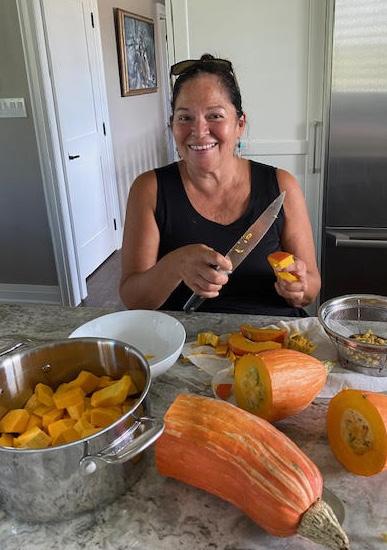
5 minute read
Seeds of our ancestors
Seeds of ancestors are revived amid magical stories of preservation
The stories associated with the Gete-Okosomin squash are magical.
Advertisement
As one expert says, they are a bit like the tendrils of the squash vine itself, twisting their way through oral history. What is certain is that the Gete-Okosomin has been grown by the Indigenous people of North America for millennia, and its seeds are now being shared to ensure that the ancient orange vegetable will continue to be planted and harvested for years to come. Some of these seeds were shared with community members at a seed gathering exchange in Minnesota by way of gardeners from Bass Lake, Ont., to Elder Shelley Charles, who is an agriculture expert for the Native Women’s Association of Canada (NWAC). The people of the Miami Nations “have been hand-pollinating and really looking after these seeds for centuries,” says Ms. Charles. “By having them in our work in the restoration of Indigenous plants in the Great Lakes region, in our gardening and agricultural initiatives, in harvesting and then also sharing the seeds, we're engaging and activating the Indigenous philosophy of thinking about seven generations into the future.” The Gete-Okosomin seeds came to her with a story. Legend had it that seeds were discovered in an 800-year-old clay pot during an archeological dig in Wisconsin and then successfully germinated into squash by Indigenous people to produce the seeds that are now being shared. Another tale suggests they may have been inside a clay ball that was used as a rattle by a baby who lived long before the Europeans arrived in North America. Yet another says they were found hidden away in a cave in Kentucky or Tennessee.

The miracle of life sprouting from centuries-old seeds prompted skeptics to research the stories. And alternative explanations for how they came to be circulated in modern times have been shared through the media and on the Internet. The most widely accepted tale suggests that David Wrone, a professor of history at the University of Wisconsin-Stevens Point, was given the seeds in 1995 by Elder gardeners from the Miami Nation of Indiana who had been growing them for 5,000 years, and that Prof Wrone subsequently gave them to the Menominee Nation before they landed at White Earth. But Kenton Lobe, a professor of international development studies at the Canadian Mennonite University in Winnipeg who received some of the seeds a decade ago, says the truth of their origin is not important. One of the Indigenous commenters to the other media stories pointed out that the seeds are sacred gift items and the stories that come with them are also sacred, says Prof. Lobe. “Rather than talk about the truth of the story, we should talk about the mingling of these stories. It is a bit like a squash vine. It grabs little tendrils here and there and can hold on in different places,” he says. “It seems to me that the tradition of tending plants and keeping seeds, all of that diversity, all of that cultural work that comes with seeds, all of the sacred work is what is important,” says Prof. Lobe. “And I think that is a really rich story to tell.” Ms. Charles has been working with NWAC to promote the work of Indigenous women in agriculture. As part of that project, a year-round greenhouse and community garden is being constructed atop the new Social and Cultural Innovation Centre that NWAC is creating in downtown Gatineau, Que. The medicines, herbs. and vegetables grown in the greenhouse will be used in the NWAC café, which will also be housed in the building. And the knowledge and techniques that are developed through the program will empower Indigenous communities across Canada to create their own gardens and greenhouses.

Very early on in the project, says Ms. Charles, it became obvious that NWAC would have to find Indigenous-sourced seeds and heirloom seeds for growing and sharing; there were none available as everything was sold out. And then she remembered that she had been given some of the Gete-Okosomin. A farming collective near her community of the Chippewas of Georgina First Nation on Lake Simcoe in central Ontario gave up a corner of their fields so she could experiment with Indigenous gardening practices and see how the seeds grow. And the results were miraculous, with over 300 pounds of squash harvested. The Gete-Okosomin squash are very large and can be stacked like cordwood, says Ms. Charles. And they are delicious. “It is like the grandmother of the squash,” she says. Through planting and harvesting, NWAC now has several thousand of the seeds, which will be distributed to Indigenous women in packages of seven. That is partly to signify that the seeds will provide food for seven generations into the future. And it reflects the Seven Grandfathers Teachings, which are common to many North American Indigenous cultures, says Ms. Charles. “This whole project is helping to restore Indigenous agricultural practices, restore that cultural knowledge of how it's intergenerational, working together as a family,” says Ms. Charles. “For urban Indigenous people who have small parcels of land or maybe even a backyard, they can learn about container growing, companion planting, permaculture, all of those things that were specific to indigenous ways of growing, nurturing, and harvesting edible plants and vegetables. And it also helps to reconnect us with the environment.” The sharing of the seeds is about food security and food sovereignty, says Ms. Charles. And it is about the circle of life, she says, reconnecting Indigenous people with the land and the water and then producing food that goes back to their families. “What is very clear,” she says, “is that these Gete-Okosomin are ancient seeds that have been kept, have been nurtured, have been looked after by indigenous people for thousands of years, and now we are restoring them.”






